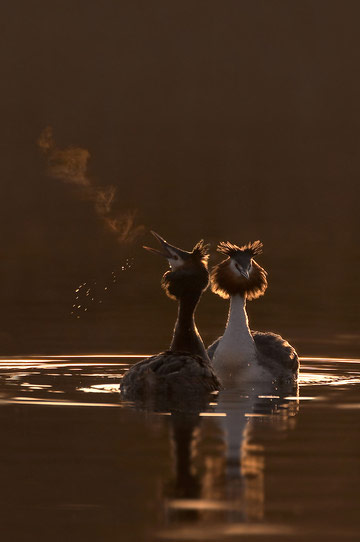
Great Crested Grebe © Ben Hall
This Atlas confirms a significant increase in Great Crested Grebes. The ‘change’ map shows a net gain of 24 tetrads with the species, 50 gains and 26 losses. The latter are scattered across the county, with no consistent pattern, and the gains are especially in the Mersey Valley, around Northwich and on the upland reservoirs, with grebes consolidating their previously tenuous hold on Wirral. With most of the gains being in or near urban areas, it is tempting to suggest that improvements in water quality underlie their rise.
The distribution map illustrates their clear easterly bias in county, with only six of the 124 tetrads with records west of the 50 line. This mostly follows the presence of large waterbodies. The submitted habitat codes show clearly their preference for the county’s larger standing waters: 1 pond; 12 small water-body; 76 lake/ unlined reservoir; 3 lined reservoir; 21 sand pit, etc; 7 river; and 3 large canal. Their diet is mostly coarse fish up to about 20 cm in length, caught by diving. At Woolston, most nests are on the river Mersey or the Manchester Ship Canal, rather than on the dredging deposit beds themselves, probably reflecting the availability of fish. The oligotrophic eastern reservoirs have obviously become more suitable for them in the last twenty years.
This is a conspicuous bird – even when out of sight, their distinctive croak can betray their presence – and most fieldworkers found it easy to obtain a two-letter code. As in our First Atlas, 72% of records were confirmed breeding. In 68 tetrads observers found adults with their stripy chicks, often carried on their parents’ backs, and a further 21 tetrads held occupied nests or nests with eggs. Pairs were found in another 21 tetrads, with nest material in three of them and in seven of them fieldworkers saw them engaged in their spectacular displays. There is plenty of time to record breeding: they can have an extended season, starting in February in some years, with a month of incubation and ten or eleven weeks before chicks can fly. Some of the early breeders might have a second brood, although most raise just one family of two or three chicks in a year. The latest chicks in the county may still be dependent on their parents into November.
There were 110 tetrads with confirmed or probable breeding, and several sites held multiple pairs, headed by Rudheath (SJ77K) and Woolston (SJ68P) with eight pairs reported at each site: the county population is at least 150 pairs. In the First Atlas it was thought unlikely to exceed 100 pairs in any one year. In the mid-19th century the secluded Cheshire meres were vital in saving Great Crested Grebes from extinction in the period of persecution for their fur and ornamental feathers, and even now the county holds an above-average proportion of the national population: there are around 4,000 pairs in Britain (Brown & Grice 2005).
Sponsored by Lymm Ornithology Group

